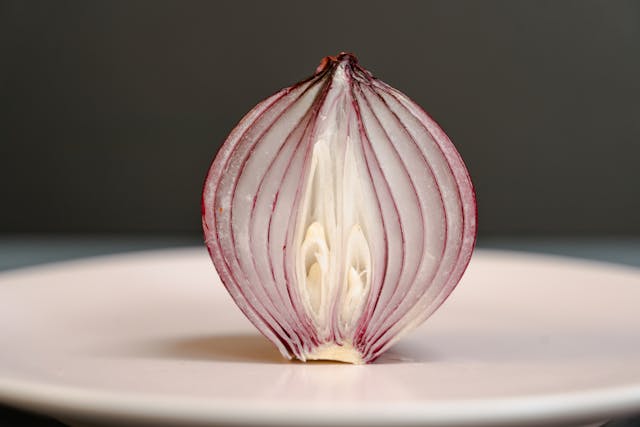
Why do onions have so many layers? Onions have so many layers because each layer is a modified leaf that has grown from the center out.
When they are first planted, onions grow from a seed. These seeds are produced by flowers at the top of the onion’s stalk. If you think about an onion in a field, you have the onion at the bottom, which is the bulb. From the base of the bulb, you have roots going down into the soil to anchor the onion plant and to bring up water and nutrients. From the onion bulb, there are long, thin leaves that reach upwards and spread out. At the base, the leaves twist together, making a thick “pseudo” stem. At the top of the leaves, the onion flowers grow, and when they dry out, they leave onion seeds. In the wild, these seeds fall off or are blown off and plant more onions. In a farm, they are collected. Once the seed has grown into an onion with a bulb, future onion plants can grow out of that bulb. In the wild, onion bulbs can grow new plants about five times. On a farm, they are usually harvested straight away.
So, why do onions have so many layers? It is a survival tactic by the plant. The onion plant has evolved to last for more than one year, and they need a way of preserving nutrients and energy for the following year’s growth, and a way to survive through the winter. The onion is their way of doing that. The bulb starts to form when small leaves grow at the base of the plant. More leaves grow from the same source, over the first leaves, and this continues. The extra leaves wrap around each other as they grow, forming the round bulb. Once the length of daylight falls to a certain amount, which differs by species, the plant starts to store sugars, nutrients, and water in the bulb. The fleshy leaves that the bulb is made of start to swell and become round. When the daylight is short enough, the top part of the plant withers, and the bulb is left. The very outer layer of leaves on the onion becomes dry and forms a protective cover over the bulb. In the wild, this bulb would survive until the following year, when a new onion plant would grow from it. On a farm, these bulbs are harvested and shipped for sale. So, the juicy onions we are eating are a survival mechanism for the plant.
Another survival mechanism that onions have is their spiciness. Unlike chili peppers, onions are not spicy until they are damaged. Chili peppers contain capsaicin, which binds to pain receptors that we, and all mammals, have on our tongues and in our mouths. Onion is not like this. Onion cells contain isoalliin, which contains sulfur. They also contain an enzyme called alliinase. The job of an enzyme is to make a chemical reaction happen. These two compounds are kept apart within the onion, but when you cut it or when it is damaged, they come together. The enzyme comes into contact with the isoalliin and they create a chemical called thiosulfinate. These smell very strongly, which is where the onion smell comes from. They also irritate the mucus lining of the mouth, which our body interprets as burning. They don’t attach to receptors in the way chili does; they just annoy the mouth. They trigger a pain receptor called TRPA1. Mustard and wasabi irritate the mouth in the same way. This chemical reaction is supposed to keep pests away. Although there are a few pests that prey exclusively on onions.
Cutting onions makes people cry for the same reason. When you cut the onion, another enzyme called LF synthases changes the sulfur in the cells into propanethial-S-oxide, which is a gas. This gas gets into your eyes and irritates them. Your body produces tears to wash the compounds out of your eyes. Your nose often runs because the tear ducts and the nose are connected, producing excess mucus. You can avoid this by cutting the onions with a very sharp knife because that will damage fewer cells. Or, you can chill the onions for half an hour before you cut them. And this is what I learned today.
Sources
https://en.wikipedia.org/wiki/Onion
https://inevitablescience.wixsite.com/inevsci/post/onion-layers
https://www.cookingscienceguy.com/pages/wp-content/uploads/2012/07/The-Science-of-Onion-Flavor.pdf
Photo by MART PRODUCTION: https://www.pexels.com/photo/sliced-onion-on-a-plate-7890211/
